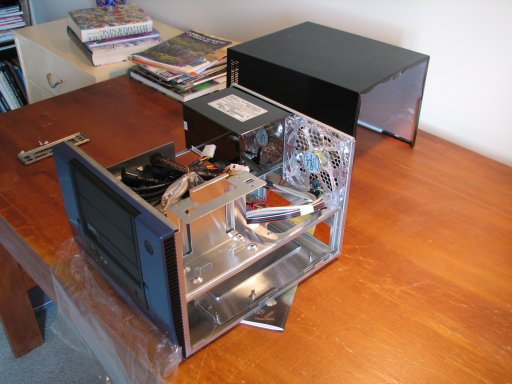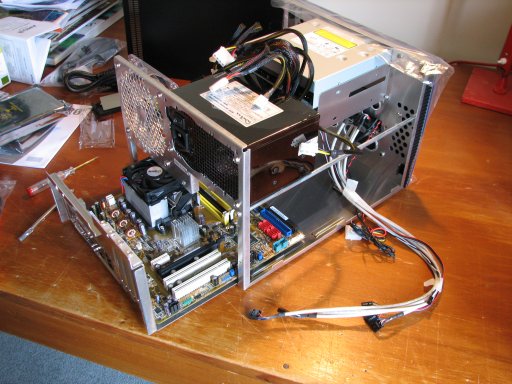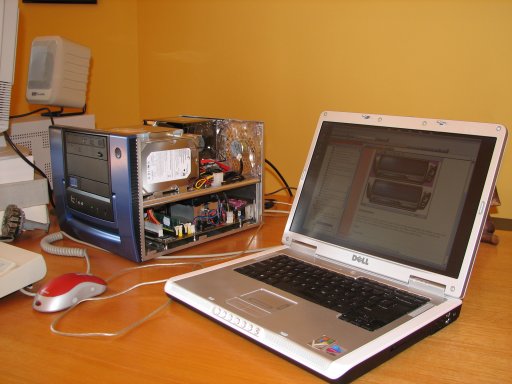In what seems like a previous life I was heavily into electronics, in fact it was my career for quite some time. I used to love building electronic gadgets, predominantly digital, which progressed naturally into micro-computers. The first computer I built had 4K ROM, 16K RAM and used a cassette tape to load and save software. As anyone who was around back then will tell you, “those were the days”. The next step was, of course, dabbling in writing programs. With such limited memory available you had little choice but to write in assembler language, so you could squeeze as much as possible into the tiny space available. This was a truly amazing learning experience, where one’s ingenuity and perseverance were critical to success.
The CP/M operating system and the first commercial PCs came along a bit after this. The first real computer I owned was a Cromenco System III which cost a fortune, had a dual 8″ floppy disk drive, 64K of memory and a 21 slot S100 Motherboard. It also weighed a ton. I found these old computer pictures while researching this article.Â
I started spending more and more time at the keyboard, than with a soldering iron and oscilloscope, eventually changing careers from electronics to software development.
Building electronic gizmos was always frustrating because you were forever having to go and buy parts to move forward, which meant the flow was continually being broken. Software is also made of parts, but the only tool you need is a computer, so you are set free to create, with few constraints to hold you back. Writing software was (and largely still is) all consuming and my interest in electronics faded, to be replaced with something far more interesting and challenging. I never did get into building “modern day PCs”, instead I’d spend time researching the latest hardware developments and then every few years or so I’d go and buy whatever PC I could afford at the time. My old computers would then become hand-me-downs to my wife Cherryl. About 4 years ago we bought Cherryl a new PC, putting her well and truly ahead of me for a time.
Time to bring this story to the here and now. I’ve commented before that I’m fanatical about backups and for quite some time I’ve wanted to have a NAS Box, as yet another piece of our backup strategy.
NAS stands for Network Attached Storage and is, in essence, a box with one or more hard drives, an operating system of some sort and a Network (LAN) connection. You then backup your all important files to this NAS box and because it is on the LAN it is accessible by all of your PCs. The NAS box itself can be accessed using a Web Browser, so it doesn’t need a monitor or keyboard and can be tucked away in a corner, out of sight.
USB Hard Drives are a great backup device, but are limited in their capabilities and must be plugged into a PC that is always turned on, and accessible on the LAN.
NAS boxes have until recently, been too expensive for small home office use, but that is changing with more affordable NAS devices starting to appear, like the Maxtor Shared Storage and D-Link DNS 323. In fact I came very close to buying a 300G Maxtor, but in the end I didn’t, for several reasons. First the low end NAS devices have limited expansion capabilities, second they can be a world unto themselves and if something goes wrong you may be left with no option but return it for service, and third they are still expensive for what they are. Having said all that, if NAS is of interest, I encourage you to seriously consider these new devices.
Where did I turn next? A few months back during my ongoing NAS research, I came across a software product named FreeNAS which enables you to use an old PC as a NAS box. This sounded very appealing indeed, especially seeing that I have around 6 old PCs gathering dust in the basement. So I went and extracted the newest of the old PCs, brought it upstairs to my office and tried to install FreeNAS. Unfortunately this wasn’t the success I’d hoped as I wasn’t able to get the PC to boot the operating system that FreeNAS uses, which is FreeBSD. I didn’t bother with the older PCs as they weren’t really up to the task and probably wouldn’t have worked anyway. I did spend a few hours on a newer PC which is more or less unused, but had no joy with that either. Next I tried Cherryl’s PC and it worked a treat, however she wouldn’t be too happy if I absconded with her PC, unless of course it was replaced with a new one. And that’s when things finally clicked into place!
Of all of our office PCs hers is the oldest, which still gets her by, but leaves a bit to be desired. Tied to this PC are a 17″ LCD and 17″ CRT monitor and the CRT has been sad since day one. So the decision was made, instead of buying a low cost NAS box, we’d buy Cherryl a new PC and a new larger LCD Monitor and I’d use her old PC along with FreeNAS to build a NAS box. But then another penny dropped, why not build a PC, and with the Xmas break looming I could find some time for such a project. This appealed from day one, I had to get my hands dirty with the NAS box anyway, so why not go the extra mile and get just the PC we want, save some money, and learn a lot along the way.
I have to say this was all a bit daunting. My dabbling with electronics is pretty superficial these days. And where would I start, working out what Motherboard, CPU, Case, Hard Drives, Video card etc. to use. And the biggest worry of all was, will it work, or will I finish up with an expensive collection of parts fit for nothing!
I’ll spare you from having to wait for the next installment and tell you the good news that yes I built it, yes it works and best of all it works very well indeed. It is easily the fastest, most powerful and cheapest computer we’ve ever owned. And it truly has been a great learning experience, which is continuing.
I’ll be writing several follow up articles which go into detail about building the PC, configuring it and later on about the NAS box, when that gets put together.
I’ll wrap this up with a picture or three of the new PC.Â
Picture 1: Unpacked Case and removed its Cover. I’ve used a MicroATX (mATX) case as I’m fed up with big tower cases.

Picture 2: Motherboard and DVD Drive installed. The motherboard is mounted on a very neat slide out tray.

Picture 3: Assembled, and running. Sitting next to my Dell Notebook. One more Hard Drive and a Floppy Drive waiting to be installed.

If this all looks way over your head, don’t be put off just yet. I was actually very pleasantly surprised at just how painless the entire exercise was. And, of course, you get a great sense of satisfaction when you build something yourself.
In Part 2 I’ll discuss the specific components I chose and why, outline the PC assembly process and provide some tips from the lessons I learnt.

Not sure if you have given up on the self-standing NAS option but I like the Ximeta Netdisk enclosure. They can be set up in a raid and you can put any drive in you want.
Thanks for the info on Ximeta, which is one I’d not heard about. Down here in Australia we don’t always see the range of products that folks in the US do.
I’ve browsed the Ximeta web site and feel they are playing a bit fast and loose with the truth when talking about their product and comparing it to NAS or Mini-NAS (a term I’d never herd before). A few points to note:
– Ximeta requires software installed and setup on each PC, NAS doesn’t. Yet they say NAS is hard to setup. I don’t agree.
– They say Mini-NAS doesn’t support RAID. I assume they are referring to the low end devices. Well the D-Link DNS-323 I referred above to does support RAID as does FreeNAS.
I seriously have to question their other claims like poor performance, poor security etc. as well.
Some important advantages of a product based on FreeNAS include:
– The ability to do byte level differential backups. ie. Only copy the data within a file that’s actually changed.
– The ability to access it remotely, over the Internet.
– You have the full power of a complete operating system at your disposal which means clever people can do anything they want.
– The ability of the NAS server to perform the backups for you. In other words instead of the PC’s pushing backups to the NAS box, it can pull them down. This centralized backup system could be a real boon where lots of PC’s are in use.
– Much easier to expand with more drives and other hardware, and I assume cheaper.
I’ve nearly completed Part of this series, and it looks like there will be more parts than I’d planned. There will be one on RAID and another on NAS.
Thanks for again for mentioning Ximeta.